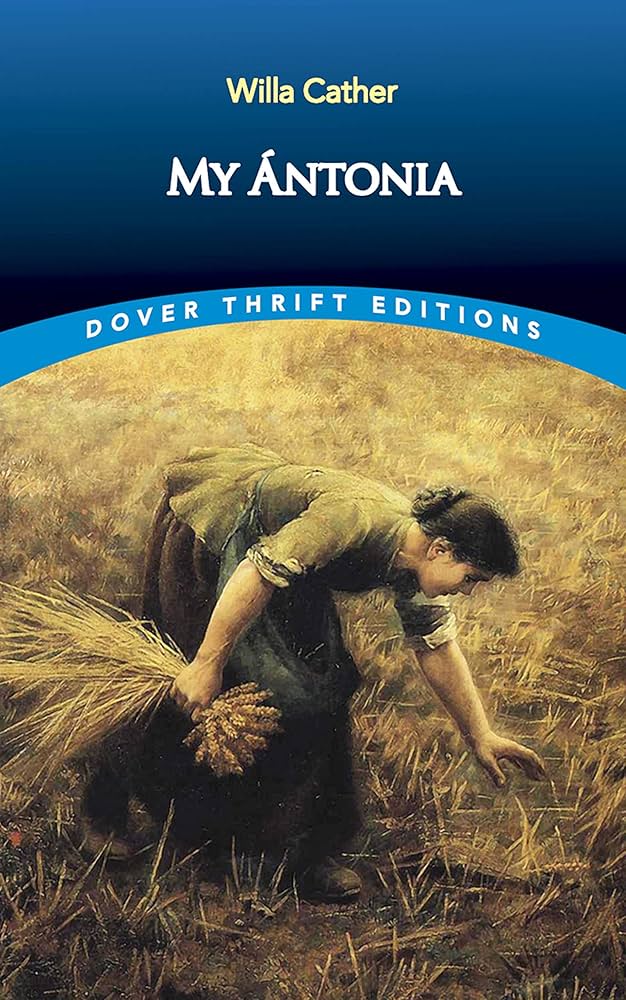Table of Contents
A Novel of Memory, Migration, and the American Landscape
My Ántonia is the crowning work of Willa Cather’s Prairie Trilogy and one of the most enduring novels of American literature. Set in the vast, untamed Nebraskan frontier during the late 19th century, the novel offers a poignant, reflective portrait of pioneer life told through the eyes of Jim Burden, an orphaned boy who grows up alongside the indelible Ántonia Shimerda, a strong-willed daughter of Bohemian immigrants.
More than a story of friendship or hardship, My Ántonia is a hymn to memory, a meditation on the land’s influence on the soul, and a timeless portrayal of resilience in the face of cultural and natural adversity.
Plot Summary: Life on the Nebraskan Frontier
The narrative unfolds as Jim Burden, now a middle-aged legal professional, recounts his early life in Black Hawk, Nebraska, through a manuscript written about Ántonia. His memories, at once intimate and panoramic, span from childhood games to adult reflection.
Ántonia, vibrant and full of life, faces grueling challenges: the suicide of her father, physical labor to sustain her family, and social stigmas as an unwed mother. Despite the hardships, she remains resilient, her spirit echoing the wild vitality of the prairie itself.
Rather than a tightly plotted novel, My Ántonia meanders like a memory—episodic, rich in atmosphere, and tied intimately to both characters and terrain.
Themes: Rootedness, Resilience, and the Making of the Self
1. The Power of Place
Cather’s landscape is not mere backdrop—it is character, force, and metaphor. The open sky, golden wheat, and harsh winters shape the people and the narrative. The land is both beautiful and brutal, and Cather’s prose captures its spiritual immensity. For Jim and Ántonia, the land is memory incarnate.
2. Female Strength and Pioneer Spirit
Ántonia challenges early 20th-century gender expectations. While men come and go, she endures. Her life, marked by toil and triumph, becomes a tribute to the strength of immigrant women who helped settle the American frontier. She embodies the Earth—fertile, weathered, eternal.
3. Memory and Myth-Making
Jim’s recounting is not objective reportage but emotional recollection. He idealizes Ántonia, merging her with his memory of youth, loss, and hope. Cather uses this to explore how stories—especially those of pioneers—are shaped, not just lived. The book becomes less a biography of Ántonia and more a mythic retelling of the American spirit.
Style and Tone: Poetic Realism and Quiet Reverence
Cather’s prose is economical yet poetic, evoking not only images but sensations—the crispness of autumn, the ache of nostalgia, the silence of snow-covered fields. Her tone is reverent, not sentimental, imbuing ordinary events with emotional gravitas. She masterfully fuses realism with lyrical reflection.
The narrative’s pacing mirrors the land: slow, rhythmic, unhurried. It invites contemplation. Cather is less concerned with dramatic arcs than with emotional resonance, capturing how small moments—like Ántonia’s laughter or a walk through windblown grass—etch themselves into consciousness.
Characters: Memory’s Subjects and Symbols
- Ántonia Shimerda – Fierce, nurturing, and symbolic of natural vitality. She is more than a person; she’s a cultural and emotional archetype for endurance.
- Jim Burden – Sensitive and observant, Jim serves as the lens through which readers view Ántonia and the American frontier. His introspective narration elevates the text into a philosophical memoir.
- Mr. Shimerda – A tragic symbol of displacement and cultural isolation, his suicide early in the novel casts a long shadow over the immigrant experience.
- The Hired Girls – A group of immigrant young women, including Ántonia, who serve as a counterpoint to the town’s bourgeois values. They symbolize vitality and labor.
Cather’s characters, especially the women, are not confined to romanticized roles. They are dynamic, fully-realized, and deeply tied to place and season.
Historical and Cultural Significance
Published just after World War I, My Ántonia offers a quieter, more rural counter-narrative to the urbanization and mechanization of American life. It preserves the voices of immigrants, especially women, who were often left out of national myths.
The novel also resists the romanticization of westward expansion, instead presenting a grounded, often painful depiction of what settlement actually required: strength, sacrifice, and unshakable resolve.
Symbolism and Allegory
- The Prairie: Both nurturing and indifferent, the prairie mirrors Ántonia’s own life—at once free and unforgiving.
- Ántonia Herself: She becomes more than a person in Jim’s narrative; she’s a symbol of the pioneer legacy, a force of fertility and continuity.
- Plough Against the Sunset: One of the novel’s most iconic images, this symbol fuses human toil with cosmic beauty, elevating the farmer’s work to an almost divine act.
Key Takeaways
- My Ántonia is a love letter to memory, place, and the people shaped by the American Midwest.
- Ántonia stands as one of the most powerful female figures in American fiction.
- Cather’s prose offers both realism and quiet poetry, creating a meditative experience.
- The novel invites readers to reflect on their own mythologies, migrations, and sense of home.
- It’s a book to be read slowly—felt, not just followed.
TL;DR
My Ántonia is not just a novel about immigrants or pioneers—it’s a meditation on the shaping of the self through land, labor, and memory. Cather’s masterpiece transcends time and plot to become a testament to endurance, belonging, and the poetic rhythm of rural life.
This is fiction at its most graceful: unhurried, heartfelt, and utterly human. Whether you read it for Ántonia’s indomitable spirit or for the beauty of Cather’s prose, you’ll emerge changed—quieter, perhaps, and more attentive to the stories that root us to place and past.

Leave a Reply